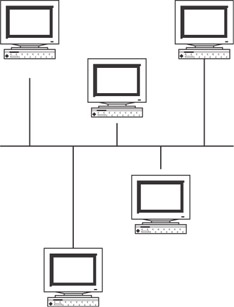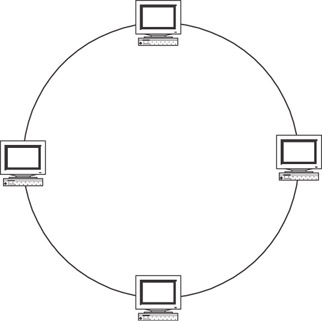Network Topology
|
| < Day Day Up > |
|
A network’s topology is the actual physical layout of the network. The topology of a network is based on factors such as the number of workstations and servers required, the communication methods that will be implemented, and the cables and specialized equipment that are available.
The three standard network topologies are bus, star, and ring. Be sure that you can identify the three main topologies and the cable type associated with each. The core exam is likely to present you with a topology diagram similar to the three figures you will see in this chapter, or to ask which cable type is associated with each topology. For example, 10Base2 is associated with a bus topology network.
The three topologies and their associated characteristics form the framework from which most networks are based. All three topologies are described next.
Bus
An Ethernet bus topology, otherwise known as a linear bus, is a topology designed for a limited number of computers that are typically attached to a single wire, or trunk, in a straight line. As more workstations are added to a bus topology, performance decreases. Figure 9.1 displays a typical bus topology.

Figure 9.1: A bus topology network.
The main type of cable implemented in a bus topology network is 10Base2 (which was described more fully in Chapter 8). Devices called terminators must be placed on both ends of a bus network or wire to keep the data signal that is placed on the wire from bouncing back and forth, a phenomenon referred to as signal bounce. All computers on the bus listen for the data signals. If the signal is addressed to a particular workstation, the workstation accepts the signal. If the physical wire or connection that makes up the bus topology is damaged or breaks, the individual computers on the bus will still be able to operate independently, but will not be able to accept data signals and communicate with other computers on the bus network.
Bus and star networks utilize CSMA/CD media access control methods to place a signal on a wire. CSMA/CD is an Ethernet error-detection method used to ensure proper data handling on a wire.
BNC (Bayonet Nut Connector) and BNC barrel connectors are used to attach a bus cable to a device or connect one piece of the bus cable to another. A device called a repeater is used to boost or regenerate the signals placed on a 10Base2 or bus network. Adding a repeater to a bus can extend the length of the entire bus network. For distances associated with a bus network, refer to Chapter 8 and 10Base2 distance capabilities.
Star
A star topology physically looks like a star. Figure 9.2 shows a simple star topology network. A star topology utilizes a central device, which can be a hub, a router, or a switch. We will refer to a simple hub for the central connection point in a star network.

Figure 9.2: A star topology network.
All devices in a star topology network are typically connected to a hub with twisted pair, otherwise known as 10BaseT cable. A star topology network is known to require large amounts of cable for larger networks. The hub provides a central location at which the network can be managed and tested. If one computer fails on a star network, the other computers connected to the hub can still function and communicate with one another. If the hub fails, however, all communication between devices will cease.
Ring
A ring topology network is best understood by picturing an actual circle of cable. Workstations and servers are all connected to the circle of cable. Each computer attached to the circle regenerates the data signal sent in the form of a token. The circling of the token to each of the servers and workstations on the ring is known as token passing. If the wire that makes up the ring is damaged, all network activity on the ring ceases. Keep in mind that IEEE 802.5 is a standard that applies to token-passing technology. Figure 9.3 displays a simple Token Ring topology.

Figure 9.3: A ring topology network.
|
| < Day Day Up > |
|
EAN: 2147483647
Pages: 237